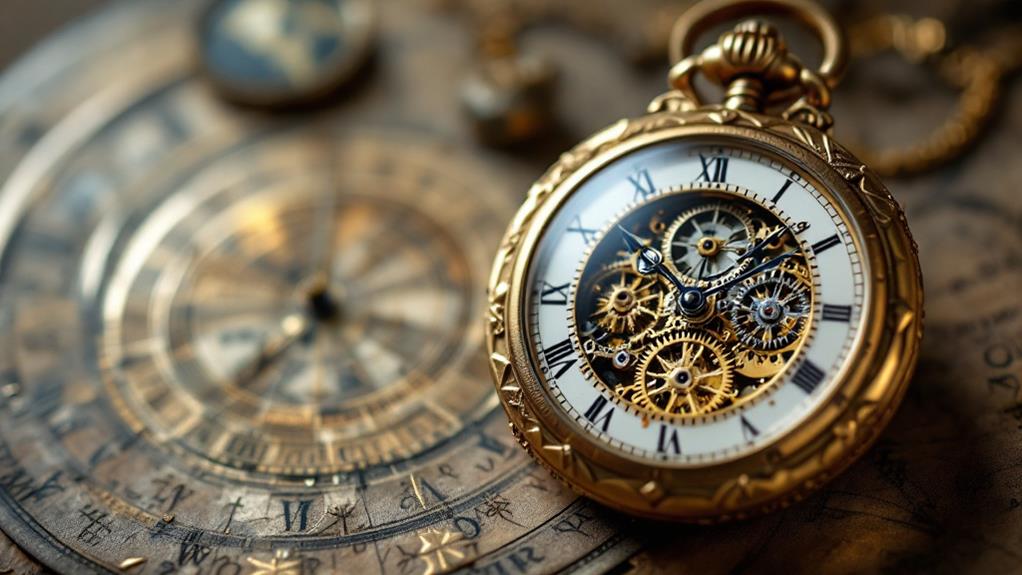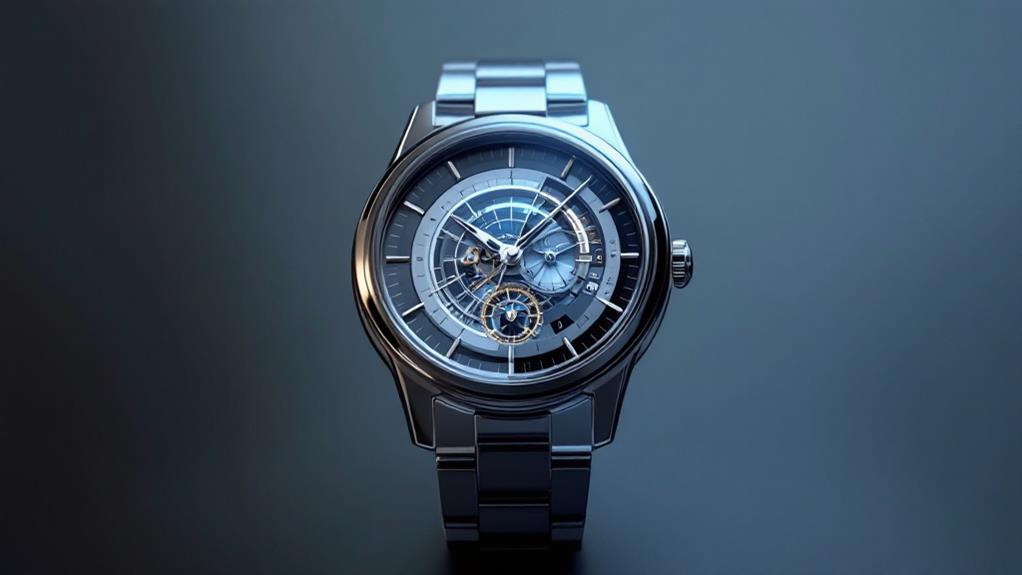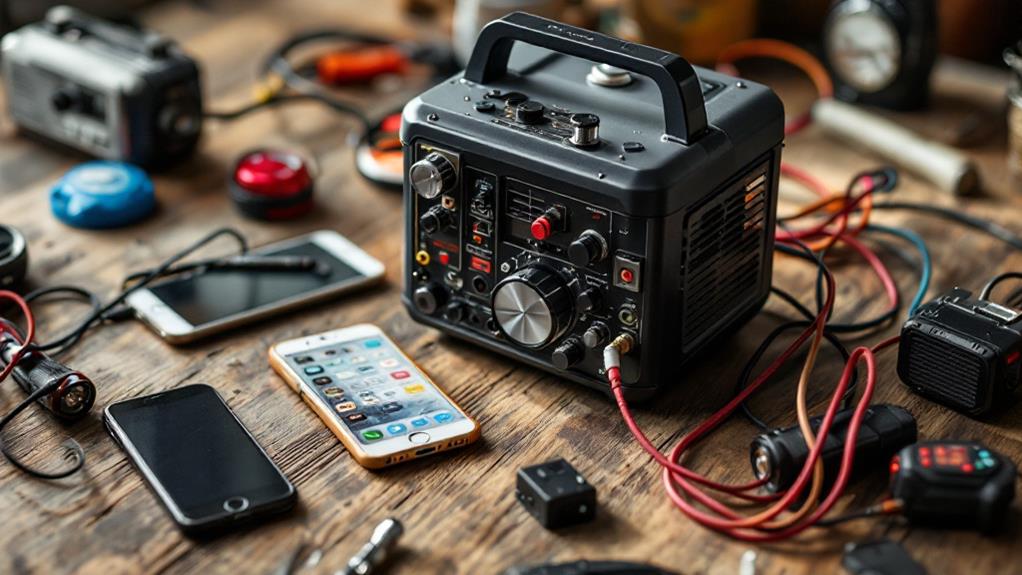When Were Watches Invented? A Timeline of Timekeeping Devices

Watches, as we encounter them presently, weren't invented instantly. Their progression spans millennia, commencing with ancient sundials and water clocks around 1500 BCE. Mechanical clocks emerged in the 13th century, leading to portable timepieces like pocket watches in the late 15th century. Wristwatches didn't take center stage until the late 19th century, initially as a feminine accessory. World War I popularized them among men, and by the 1920s, they became fashionable for everyone. The quartz revolution in the 1960s brought unparalleled accuracy to timekeeping. This expedition through time reveals captivating innovations that shaped our relationship with timekeeping devices.
Ancient Timekeeping Methods
Throughout history, humans have sought ways to measure time. Ancient civilizations developed various methods to track the passage of hours and days, laying the foundation for modern timekeeping devices.
One of the earliest and most widespread timekeeping tools was the sundial. You've probably seen these simple yet effective devices, which use the sun's position to cast shadows on a marked surface. Sundials were used in ancient Egypt, Mesopotamia, and China, with some dating back to 1500 BCE. They're still popular as decorative garden features today.
Water clocks, also known as clepsydras, were another ingenious invention. These devices measured time by the regulated flow of water from one container to another. You'll find that water clocks were more accurate than sundials and could be used at night or on cloudy days. The ancient Egyptians developed them around 1400 BCE, and they spread to other civilizations, including Greece and Rome.
Other ancient timekeeping methods included candle clocks, hourglasses, and incense clocks. While these devices weren't as precise as modern watches, they played an indispensable role in human society's development and our understanding of time.
Mechanical Clocks Emerge
When did mechanical clocks first appear on the timekeeping scene? You'll find their origins in the late 13th and early 14th centuries. These early mechanical clocks, often installed in church towers or town squares, marked a significant leap forward in timekeeping accuracy.
As you investigate the evolution of mechanical clocks, you'll notice several key advancements. The invention of the verge escapement in the 14th century allowed for more precise timekeeping. However, it wasn't until the 17th century that pendulum technology truly revolutionized clock accuracy.
You'll see that miniaturization innovations played an essential role in the development of portable timekeeping devices. Clockmakers began creating smaller, more intricate mechanisms, opening the door for table clocks and eventually pocket watches.
By the 16th century, you'd find mechanical clocks becoming more common in wealthy households. These clocks often featured elaborate designs and additional functions, such as striking mechanisms and astronomical displays.
As pendulum technology advancements continued, you'd witness a dramatic improvement in timekeeping accuracy. Clockmakers like Christiaan Huygens refined pendulum designs, leading to clocks that could keep time to within seconds per day.
The Birth of Portable Timepieces

As mechanical clocks became more refined, the demand for personal timekeeping devices grew. You might be surprised to learn that the first portable timepieces weren't wristwatches, but rather pocket watches. These early timekeepers emerged in the late 15th century, marking a significant leap in horological technology.
Early clockmakers faced numerous challenges in miniaturizing clock mechanisms. They had to create smaller, more precise components that could withstand the jostling of everyday movement. The first pocket watches were bulky and inaccurate, but they quickly evolved. By the 16th century, you'd find pocket watches becoming more common among the wealthy elite.
These portable timepieces weren't just functional; they were also status symbols. Craftsmen adorned them with intricate engravings, precious metals, and jewels. As manufacturing techniques improved, pocket watches became more reliable and affordable. By the 18th century, they'd become essential tools for orientation and timekeeping at sea.
The birth of portable timepieces revolutionized how people interacted with time. No longer bound to stationary clocks, individuals could carry accurate timekeeping devices wherever they went, charting the course for the wristwatches you're familiar with today.
Wristwatches Take Center Stage
The shift from pocket watches to wristwatches began in the late 19th century. Initially, wristwatches were considered a feminine accessory, often adorned with jewels and intricate designs. Men continued to favor pocket watches until the early 20th century when military personnel discovered the practicality of wearing timepieces on their wrists during combat.
World War I played a vital role in popularizing wristwatches among men. Soldiers found it easier to check the time without fumbling for a pocket watch, leading to the widespread adoption of wristwatches in military operations. After the war, returning soldiers continued to wear their wristwatches, gradually changing public perception.
By the 1920s, wristwatches had become a fashionable accessory for both men and women. Manufacturers began producing a wide variety of styles, from refined dress watches to rugged sports models. As technology improved, wristwatches became more accurate and reliable, solidifying their status as a portable accessory.
The wristwatch's evolution from wrist adornment to essential timekeeping device transformed it into a symbol of style and functionality. Today, despite the prevalence of smartphones, wristwatches remain popular as both fashion statements and practical tools.
Quartz Revolution

You might think mechanical watches had reached their pinnacle, but the 1960s ushered in a revolutionary change: quartz technology. This innovation transformed the watchmaking industry, offering unparalleled accuracy and reliability.
Quartz watches use battery-powered oscillators to keep time, eliminating the need for complex mechanical movements. In 1969, Seiko introduced the Astron, the world's first commercial quartz wristwatch. Its accuracy far surpassed traditional mechanical timepieces, losing only a few seconds per month compared to several seconds per day.
The quartz revolution quickly gained momentum, with manufacturers rushing to adopt the new technology. By the 1970s, quartz watches dominated the market, offering affordable and precise timekeeping to the masses. This shift also paved the way for digital display technology, which allowed for easier time reading and additional functions like alarms and stopwatches.
As quartz watches became more prevalent, traditional mechanical watchmaking faced a crisis. Many Swiss manufacturers struggled to adapt, leading to what's known as the "Quartz Crisis." However, this upheaval ultimately pushed the industry to innovate and diversify, resulting in a renewed appreciation for both quartz and mechanical timepieces in the decades that followed.
Smart Technology Meets Timekeeping
Just when you thought watches couldn't evolve further, smart technology arrived to redefine timekeeping once again. The advent of smartwatches in the early 2010s marked a contemporary period in personal timekeeping. These devices combine traditional timekeeping functions with advanced features like fitness tracking, mobile notifications, and digital time management tools.
Apple's introduction of the Apple Watch in 2015 revolutionized the market, sparking widespread adoption of smartwatches. Other tech giants and traditional watchmakers soon followed suit, offering their own versions of connected timepieces. These devices seamlessly integrate with smartphones, allowing for connected device synchronization and providing users with a wealth of information at their wrists.
Smartwatches have expanded beyond simple timekeeping to become powerful personal assistants. They can monitor your heart rate, track your sleep patterns, provide GPS navigation, and even make phone calls. With constant software updates and improvements, smartwatches continue to evolve, blurring the lines between traditional timepieces and avant-garde technology. As we move forward, it's clear that smart technology will play an increasingly significant role in how we manage our time and interact with the world around us.



